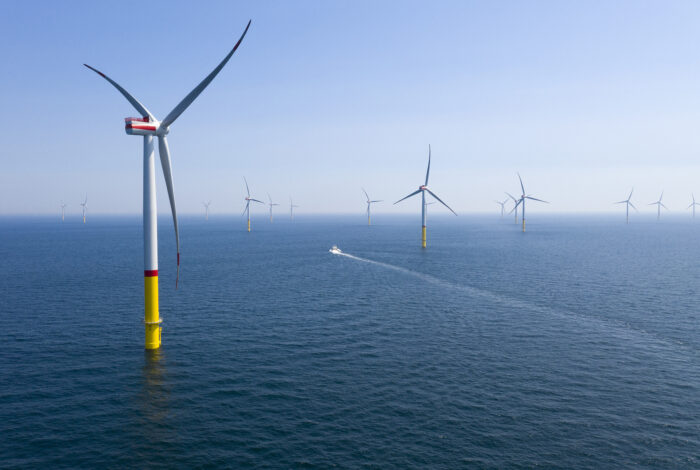The Bureau of Ocean Energy Management has identified two spots on the Oregon Coast for floating wind farms. Some of the most powerful and consistent winds in the world are located off the southwest Oregon coast, according to the Oregon Department of Energy. The pictured turbines were photographed in 2019 in Germany. (Axel Schmidt/Getty Images)
Officials from the Confederated Tribes of Coos, Lower Umpqua and Siuslaw Indians are suing the U.S. Bureau of Ocean Energy Management over its decision to greenlight two areas off the Oregon Coast for potential floating wind energy projects.
The southern Oregon tribe – which passed a resolution against floating offshore wind energy in those areas last November – filed its suit Friday in U.S. District Court in Eugene against the ocean energy bureau, accusing it of violating two federal laws meant to protect the environment and culturally significant areas.
“The decision to file this legal action was not taken lightly,” Brad Kneaper, chair of the tribal council, said in a news release. “We would much rather work collaboratively with the Bureau of Ocean Energy Management to determine where the best places are to develop wind energy, minimizing the impacts to the coast and our people.”
The suit comes two weeks after federal officials announced they would hold an auction for companies interested in surveying and proposing floating offshore wind energy farms in two lease areas. One area, a 61,000-acre site, is located 30 miles off the coast of Coos Bay, while the other, spanning nearly 134,000 acres, is located 20 miles off the coast of Brookings. If fully developed, wind farms on the two sites could generate more than 3.1 gigawatts of renewable energy, enough to power 1 million homes, federal officials said.
Tribal officials say the two proposed offshore areas are in the tribes’ ancestral territory and that the areas are home to fish and other marine species and have views of significant cultural, historic and economic significance to the tribe.
Kneaper said in the release that the tribe is willing to withdraw the lawsuit if the October lease sale is delayed and the bureau commits to assessing the cumulative and future impacts of wind energy development not just along the Oregon Coast, but also across all development areas being auctioned off along the West Coast.
“BOEM does not discuss pending litigation through the media,” John Romero, a spokesperson for the ocean energy bureau, said in an email.
The lawsuit
In the suit, the tribe, represented by attorney Rick Eichstaedt of the Spokane-based law firm Rey-Bear McLaughlin, accused the ocean energy bureau of violating the federal National Environmental Policy Act, or NEPA, as well as the National Historic Preservation Act, which requires federal agencies to protect culturally significant sites.
The tribe claims the agency failed in an environmental assessment to consider not just the current impacts of surveying and potentially developing the areas for wind energy, but also future impacts as well as the cumulative effect of wind power generation along the entire West Coast, not just off the coast of Oregon.
The bureau has auctioned five areas off the California coast for floating wind energy projects. In July, it released an environmental assessment of the two Oregon lease areas, and said there would be no significant impact to people or the environment as companies survey, study and plan proposals.
Any projects proposed by developers would need to go through another environmental impact analysis, and the public and interested parties would also be able to comment before it could be approved and built.
Kneaper said the July assessment ignored the cumulative and future impacts of wind development, and failed to identify alternative areas that did not have the same cultural and historic importance for the tribe and marine species.
“The tribe has consistently urged that BOEM delay moving forward with wind energy development until a better understanding is made of the impacts to fish, wildlife, the marine environment and cultural resources important to the tribe,” he said. “No one, including BOEM, has an understanding of how wind development will impact the fragile marine environment.”
Kneaper accused the bureau of being driven by politics and ignoring concerns among coastal residents. In November, Coos County residents will vote on a ballot initiative to oppose offshore wind development, and a coalition of independent fishing boat operators, seafood companies and industry groups have also asked Oregon Gov. Tina Kotek to intervene to stop floating offshore wind development from moving forward.
Wider picture
Under Oregon’s climate change policies, the state needs to curb its greenhouse gas emissions by mid-century. The Climate Protection Program, which is currently being redone by the Oregon Department of Environmental Quality, has set a target of reducing emissions from fossil fuels in Oregon by 50% by 2035 and by 90% by 2050.
Wind energy will be needed to help achieve those goals, officials say, and offshore wind is slated to be part of the solution. The Oregon Department of Energy’s latest energy report said the state needs about 20,000 megawatts of energy to come from offshore wind by 2050 to meet that target.
The Biden administration also has wind energy plans. It is planning for up to a dozen offshore wind energy auctions through 2028, with the hope of developing a total of 30 gigawatts of wind energy – enough to power more than 10 million homes – on the East and West coasts to be deployed by 2030. The Oregon sites would account for about 10% of that, according to the bureau.
Oregon Capital Chronicle originally published this article. Like the Alaska Beacon, it is part of States Newsroom, a nonprofit news network supported by grants and a coalition of donors as a 501c(3) public charity. Oregon Capital Chronicle maintains editorial independence. Contact Editor Lynne Terry for questions: info@oregoncapitalchronicle.com. Follow Oregon Capital Chronicle on Facebook and X.
GET THE MORNING HEADLINES DELIVERED TO YOUR INBOX

